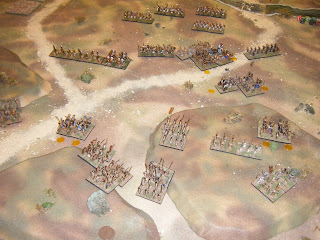The original plan for the Bronze Age was to use Warhammer Ancient Battles, but lately I have been considering other options, since WAB really prefers individually-based figures and we've been painting them up in stands of about 4-8 figures. As it happens, a few weeks ago my dad and my brother and I played a game via Skype against our friend Ross McFarlane, using his Rough Wooing rules for Renaissance warfare. On the way back from Cold Wars the other weekend, Dad and I got to discussing whether Rough Wooing could be adapted for the Bronze Age, as it is more amenable to our current basing scheme.
I decided I would give it a try, and since Dad's currently off on a business trip, I enlisted my brother William to command the Egyptians. The scenario was a pretty straightforward one, with Egyptians deployed with their backs to a river and the Hittites coming down out of the hills. Going into the game, the only major adjustment I made to the rules was the addition of javelins, since several units on both sides are equipped with them. I gave them a range of 6" and figured they'd be treated like any other ranged weapon. Rough Wooing contains several different grades of cavalry, but I compressed these down to two: the heavier lance-and-javelin-armed Hittite chariots were given a move of 3d6, a frontal to-hit of 3-6, a flank to-hit of 5-6, and an armor save of 4-6, while the lighter bow-armed Egyptian and allied chariots were given values of 4d6, 4-6, 5-6, and 5-6 respectively.
Given the size of our table and the fact that both sides put their chariots out in front, the game began with a series of chariot clashes all along the table. Despite their advantages, my chariots did not come out ahead in the melees; two groups were forced to fall back. (Looking back, the Egyptian chariots probably should have been given the option to pursue.)
Before and after the first melee. Note that the Egyptians have lost a chariot group in the center--not from the melee, but from bow-fire from the archers on the hill and javelins from Hittite chariots that weren't quite in charge range.
The evolving board position.
The last clash in the center brought up one final problem. Working on the notion that my blocks of spearmen were probably not the equal of Renaissance pikes, I decreed that they wouldn't get to use the special pike advantage of rolling four dice instead of two. Unfortunately, this made them strictly worse than everyone else, since they could only hit on a 5 or 6 and had no armor, while the troops they were facing would hit on a 4, 5, or 6 and had some minimal armor which saved them a few casualties.
While the game sort of worked, I was not entirely satisfied with how it went. Ranged combat seemed to have a definite advantage over hand-to-hand, which didn't seem appropriate for the period I am attempting to simulate. The number of javelin-armed units did not help in this regard. So, changes that will be in effect for the next game:
- Maximum of two dice of ranged fire per stand. (We actually switched to this pretty early on in this game; the rules as written say one die per figure, expecting stands of 2-4 figures.)
- Ranged attacks hit on a 5 or 6 instead of a 4, 5, or 6.
- Javelins will have a range of 0"--javelin-armed units will be allowed to use them when charging or being charged, but not for continuous long-range bombardment. (Casualties will count towards melee results as per existing rules for reaction shooting.)
- Spears will get their four dice per stand.
There will also be a couple of minor tweaks to the scenario:
- Hittite infantry will start in line instead of column.
- Both sides' chariots will be split into left and right-hand divisions instead of being clumped together. (I've been using the term 'division' in place of the original rules more period-specific 'battle.')
- Overall commanders will not start out attached to the front rank of chariots. (Given how quickly the melee in center developed, we realized having both generals in the front rank was probably a recipe for an overly-quick game.)
Anyway, tomorrow we'll play it again and see how it goes!











Very nice looking units. Have you considered using Warmaster Ancients? Those rules are based around stands, rather than individual figs, and produce quite a cool game.
ReplyDeleteWarmaster, the fantasy game from which it derived, is available for free on the GW site, if memory serves.
Nick
Looking good. Basic Impetus is another option to consider, its free if you google it. However, I've occasionally thought of ancient-afying RW myself.
ReplyDeleteI would treat the 2 handed spear guys as pike, its meant to reflect a tactical bias towards solid blocks more than anything and in any case, any advantages are relative not absolute. I'd probably treat the 1 handed spear and shield guys the same as swordsmen.
For javelins, you may want to consider letting the really light skirmishing type guys use their javelins as missile weapons while confining the heavier light infantry to throwing them during a charge.
Nick: I may look into it. Do you know if Warmaster Ancients is like WAB in having "source book"-type things for particular sub-periods?
ReplyDeleteRoss: That could work, but for now it's a bit irrelevant since at the moment all the really light skirmishers are bow-armed; everyone with javelins has them as supplements to melee weapons.
Looks good! Wish I was there to help out...
ReplyDeleteHi Norman,
ReplyDeleteNo, WMA is all inclusive - combat rules and army lists...apart from the second book, which contains a campaign system and more army lists. It's pretty cool.
http://20mmgamer.blogspot.co.nz/search/label/WMA
Nick